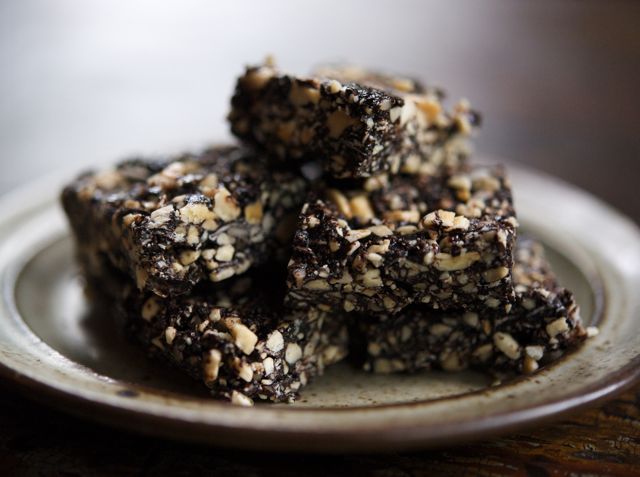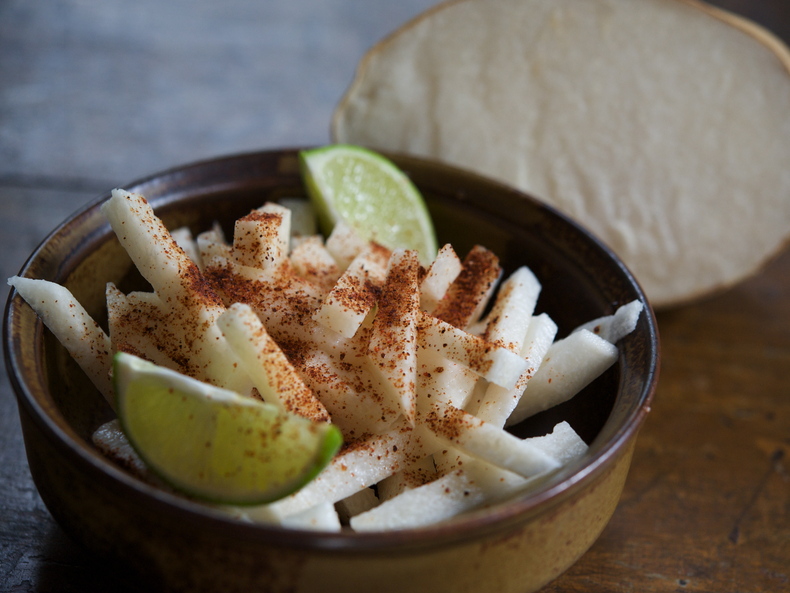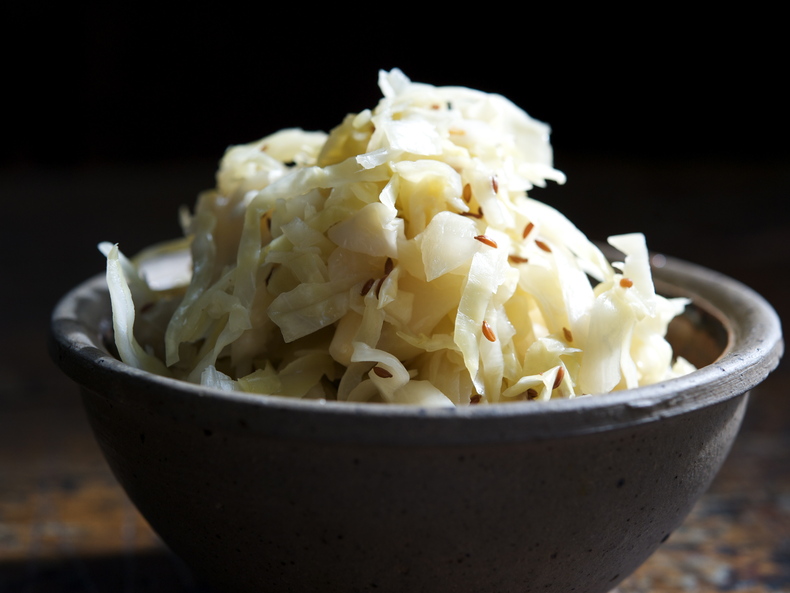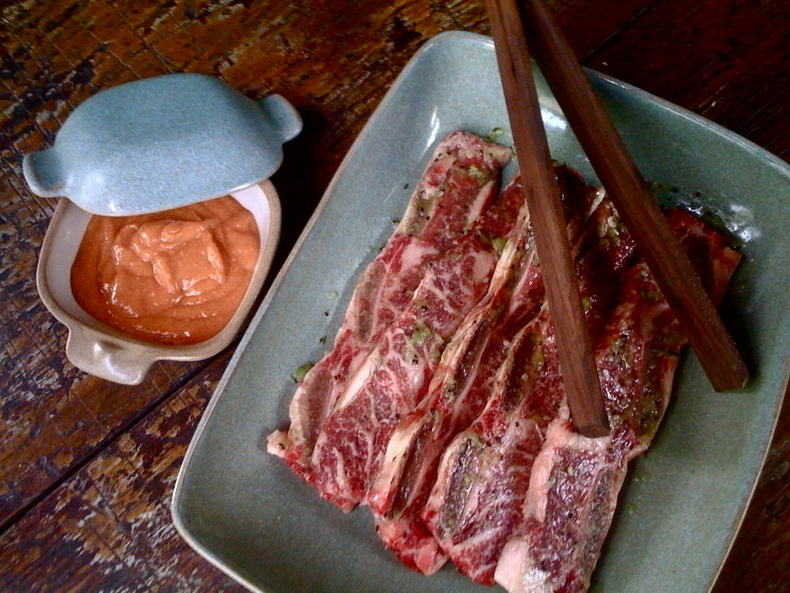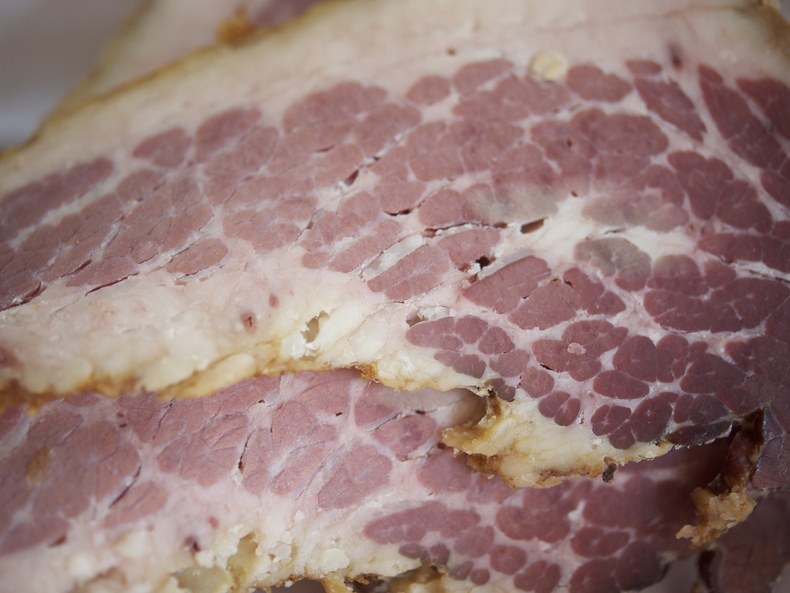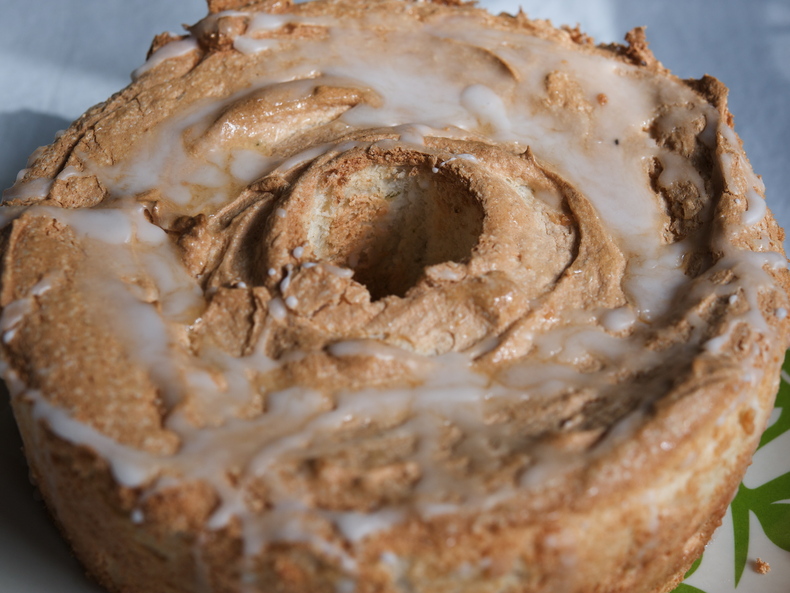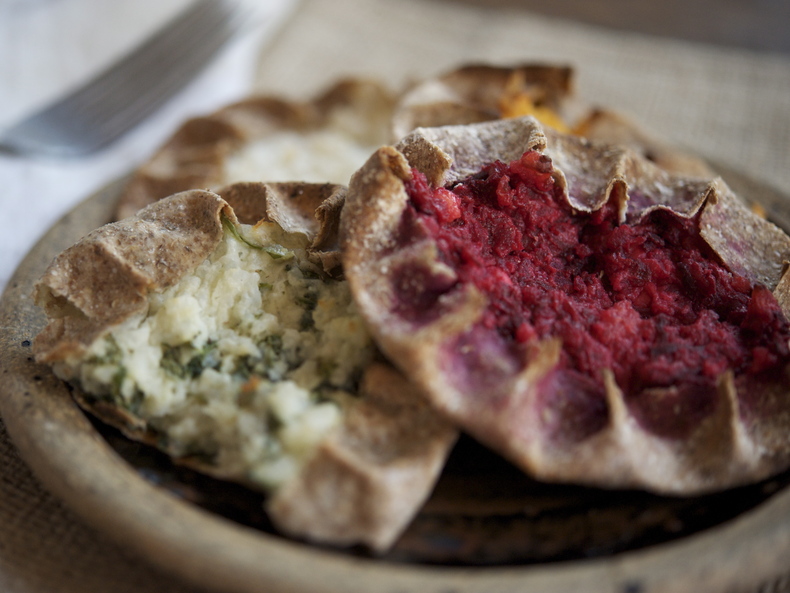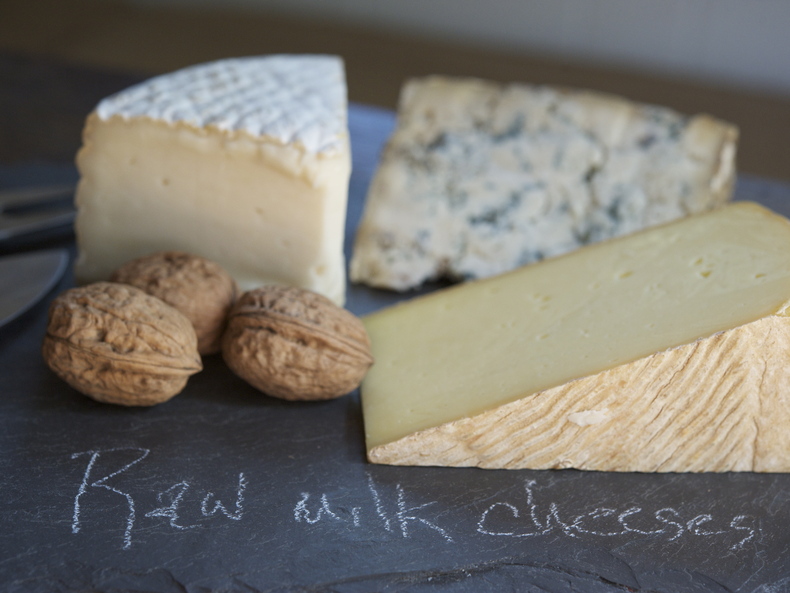Growing up in Santa Cruz, still a hippie mecca to this day, I was exposed early on to all manner of what used to be known as "health foods"—sprouts, carob, smoothies, kefir, whole grain sourdough bread. Maybe that's why I still enjoy trawling about crunchy food co-ops, peering at bags of sesame sticks, bins of millet and containers of powdered spirulina. There is almost always an assortment of carob-covered items (raisins, almonds, ginger) and sometimes these little nuggets, studded with lots of goodies. I love carob's dark, earthy richness; its mild bitterness and distinct winey taste hold up to chocolate's complexity. Carob is a species of flowering evergreen tree in the pea family that is cultivated for its edible seed pods, which are also known as "St. John's bread" because John the Baptist was said to have subsisted on them in the wilderness. Supposedly they also fed Mohammed's armies. The pod can be elongated, compressed, straight or curved and takes a full year to develop and ripen. It is the dried and sometimes roasted pod that we eat, and not the peas or seeds inside. These are called locust beans and are used for animal feed or as the source of locust bean gum, a thickening agent that is an ingredient in many processed foods.
Read More...
Eating
Twitter @glutton4life
6.14.10 Green Light
Spinach plucked fresh from the garden is one of the great joys at this time of year. Thought to have originated in ancient Persia, Arab traders carried spinach into India, from where it was introduced to China. The earliest record of spinach is in Chinese from around 647 AD. When Catherine de’Medici, born in Florence, became queen of France, she insisted that spinach be served at every meal. That’s why, to this day, dishes made with spinach are known as "Florentine."Highly nutritious and full of antioxidants, spinach is a rich source of vitamin A, vitamin C, vitamin E, vitamin K, magnesium, manganese, folate, betaine, iron, vitamin B2, calcium, potassium, vitamin B6, folic acid, copper, protein, phosphorous, zinc, niacin, selenium and omega-3 fatty acids. No wonder it made Popeye so strong! Consider this: a 180 gram serving of boiled spinach contains 6.43 mg of iron, versus the 4.42 mg in a 170 gram ground beef patty. However, spinach contains oxalic acid, which binds with iron and prevents its absorption, so it is best eaten with foods high in vitamin C and calcium that help it be absorbed by the body. These include meat, fish, poultry, dairy, citrus, cantaloupe, strawberries, broccoli, brussels sprouts, tomato, potato, red peppers and white wine. The dark green, crinkly spinach is called Savoy; there is also a kind with flat, smoother leaves; and there is a hybrid type that is somewhere in between. To maximize its nutrients, spinach is best eaten when fresh, lightly steamed or blanched. But I also love it creamed (which means somewhat more cooked down) and raw in salads.
Read More...
Read More...
6.10.10 Crunch Time
I learned all kinds of crazy things about my beloved jícama as I was doing a little research for you. The word jícama derives from the Nahuatl “xicamatl" for a native Mexican vine, although what we eat is the plant's tuberous root. It’s from the genus Pachyrhizus, commonly referred to as "yam beans," which is yet another name for jícama. The roots can grow to be quite large, although when bigger than a canteloupe, they begin to convert their sugars into starches, becoming dry and woody. In choosing a jícama, look for medium-sized, firm tubers with no wet or soft spots. It will keep under refrigeration for up to two weeks, but I learned that optimal storage temperature is between 50 and 60 degrees, under which conditions it will keep for a month or two.
Read More...
Read More...
6.9.10 Condimental: Bubble & Squeak
This is not about that traditional English dish of fried leftover vegetables. I'm actually referring to the lovely sounds that emerge from the jar when you make your own sauerkraut. More broadly, in fact, I want to tell you about the joys of lacto-fermentation. WTF?! you cry. What is she going on about now?! Yes, it's more of my kooky DIY. But you can't tell me that you don't love pickles. And this is one way to make them that doesn't require all that boiling and canning hassle. This is just you, your vegetables and some free-floating healthy bacteria! Lactobacilli are lurking everywhere, on the surface of all living things, especially anything growing on or near the ground. Put them to your own use and you've got all manner of delectable pickles like kimchi, sauerkraut and half-sour dills. Make no mistake: lacto-fermentation is not the same as pickling in a vinegar brine. I was amazed to see that my sauerkraut was simply salt, caraway seeds and cabbage; a dry mixture that, over a period of days, became juicy and sour and fragrant.
Read More...
Read More...
6.6.10 A Good Ribbing
My dear friend Mirena taught me pretty much everything I know about Korean food—which is actually not that much, but enough so that everyone looks to me to order when we go out for barbecue on 32nd Street. I know how to grill the meat over hot coals and wrap it in lettuce with a smear of fermented soy bean paste; and how to say dumplings (man doo); and that a seafood pancake is a must; and of course that both types of meat—bulgogi (rib eye) and kalbi (short rib)—must be ordered. On my regular stop at Dickson's in Chelsea Market this week, I was pleasantly surprised to see thinly sliced short rib (vertically sliced) all ready for homemade Korean barbecue. I found recipes for the classic marinade and dipping sauce from Jenny Kwan, an owner of a popular Korean restaurant, Dok Suni, in New York's East Village. I picked up a great tip: she has you massage the meat with kiwi juice, a natural tenderizer containing enzymes that break down protein! Now that grilling season is upon us, I think you should give this easy preparation a whirl.
Read More...
Read More...
6.4.10 Berry Intense
In yet another attempt to resolve his GI issues, G is going to start a new herbal protocol given to him by herbalist extraordinaire Bryan Thomson. It's going to require him to abstain from all dairy for 6 weeks. Out of solidarity, I will do the same. That means that we must quickly polish off this delectable strawberry ice cream that I made with the über-ripe berries we brought back from Stephanie's last weekend. Always looking for a new place to try my expensive and highly coveted fennel pollen, I added a teaspoon here and I think it really worked. You could omit it, or even try using a few toasted and ground fennel seeds. The ice cream's gorgeous pink color is from a puree that's stirred into the custard. Then, once the ice cream is almost done, you toss some chunks into the machine to get mixed in. That way you get some icy bites of strawberry to break up the smooth and creamy texture. Who needs rose-colored glasses?
Read More...
Read More...
6.3.10 Beef Eaters
Pork is not in circulation at our house right now (part of an elimination diet we're trying), and although there are plenty of other things to eat, bacon is pretty hard to replace. So I was intrigued when I spotted beef bacon at Dickson's the other week. Turns out it has a nice smoky flavor and, though not fatty enough to become truly crispy, it's got a meaty chew that is rather pleasant. Because eating meats raises the level of acidity in the body, it's good to accompany them with plenty of alkalinizing fresh and cooked vegetables. One of my favorite ways to cook greens is with a piece of smoky meat, whether it's pork, beef, poultry or even dried bonito. It's an easy way to adds a lot of flavor.
Read More...
Read More...
6.1.10 The Good Angel
Memorial Day weekend always marks the start of summer for me. I think back to halcyon days spent at The Shack on the North Fork, an era that has retained its halo for more than a decade now. I love that I'm still celebrating the new season with some of the same friends, but now we're doing it with a view of the woods instead of the water. Sunday's gathering at Stephanie's in Stone Ridge (our first visit there since New Year's Eve) featured an elaborate Mexican-themed buffet with the fixings for fish, beef or pork tacos. We sipped watermelon margaritas and thirst-quenching tamarind coolers, and afterward I trotted out this light, lime-glazed angel food cake with two drizzling sauces: Mexican chocolate (with the same chocolate I used for this ice cream) and fresh raspberry.
Read More...
Read More...
5.28.10 Finnishing School
I love discovering new things. Isn't that one of the great joys of life? I know it's a bit of a cliché, but retaining a childlike openness really does keep you young at heart. II never want to turn into one of those cranky old people afraid to try anything new, no matter how many painful setbacks my life hands me. You probably think I'm buttering you up to eat something like monkey brains, right? Worry not. I just want to introduce you to Finnish ryes. My Finnish friend Maija, a very talented writer, does a little side business in these lovely pasties (not a typo, the plural of pasty!). They are based on a traditional recipe from Karelia, a region in Eastern Finland and Western Russia, using flour made mostly from whole grain rye (plus a tiny amount of wheat). Rye flour has a low glycemic index and a high amount of dietary fiber and protein, so these make for a healthy, nourishing snack. Maija and her baking partner have come up with a selection of flavors that pay tribute to tradition but also appeal to the rather more rarified tastes of New Yorkers. This includes the most basic rice-filled version, as well as beet-feta, spinach-garlic and sweet potato-caramelized onion-rosemary. The ryes can be eaten at room temp or pop them in the oven (even better). I enjoyed mine with a fried egg on top. Look for them at the Park Slope Greenmarket (5th Avenue) on Sundays through the fall.
Read More...
Read More...
5.27.10 Totally Rawesome
I can't take credit for that: my friend Louise told me about a Rawesome food co-op in Venice, California, that sells raw milk—she's going there to stock up! I feel like the Pied Piper of natural dairy. Love it. I'm jealous because they sell raw butter there. The farm I buy from doesn't separate the cream from the milk and I haven't quite figured out how to do that successfully. Every source says you just wait for it to rise to the top and skim it off, but that seems to leave me with something more like half-&-half. Any thoughts? Raw cheese, on the other hand, is pretty easy to find—as long as it's aged. I guess they figure any harmful bacteria will have died off, so by law raw milk cheeses have to be aged at least 60 days to be considered fit for human consumption. Whatever. You know I'll get my hands on some fresh raw milk cheese very soon. Thinking about making my own mozzarella. Yep, I'm a radical. (By the way, did I ever tell you that my father contracted bovine tuberculosis in Mexico when he was 19? Saved him from going into the service during WWII! Nowadays, even mom-&-pop farms do regular testing to make sure that doesn't happen.) So I did pick up some raw milk cheeses at Lucy's Whey in the Chelsea Market this week. I sampled them for lunch today and they were truly delicious. (I also picked up that lovely tray from Brooklyn Slate. Great packaging; would make a nice housegift for some cheese-loving host.)
Read More...
Read More...






